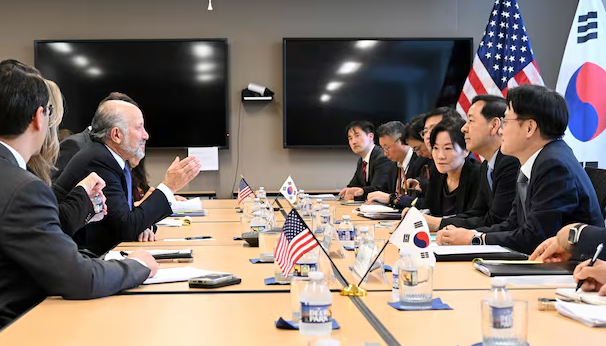US Korea Trade & Investment Talks: What’s Happening and Why It Matters
Trade and investment relations between the United States and South Korea are some of the most important in the world. Both countries are close allies, and their economic partnership plays a big role in global markets. Recently, discussions about a large investment package have stalled. South Korea has promised $350 billion in investments as part of a broader trade deal, but disagreements have slowed progress.
This article explains the background of the talks, the issues causing delays, and what it could mean for both countries and the global economy.
Background of the Investment Package
South Korea announced a commitment of $350 billion in investments linked to trade and economic cooperation with the United States. The plan covers multiple areas such as:
-
High-tech industries like semiconductors and batteries.
-
Green energy projects including hydrogen and renewables.
-
Financial cooperation through stronger capital markets.
The idea behind this package is to strengthen economic ties, support US supply chains, and give South Korea more access to global markets.
Why the Talks Are Stalled
Although both sides see benefits, several challenges are slowing progress:
1. Disagreements on Payment Structure
The US and South Korea do not fully agree on how the investments should be paid and managed. Washington wants clear timelines and structured commitments, while Seoul is asking for more flexibility in payment terms.
2. Need for Financial Protections
South Korea is pushing for safeguards to reduce financial risk. One major proposal is a currency swap mechanism with the United States. This would help protect South Korea if there is sudden instability in currency markets.
3. Different Priorities
The US is focused on securing supply chains, especially for semiconductors, batteries, and green technology. South Korea agrees, but it also wants guarantees that its companies will get fair treatment and strong protections when investing in the United States.
The Role of Diplomacy
Recently, South Korean President Lee met with US Treasury Secretary Scott Bessent during the United Nations General Assembly (UNGA) in New York. The goal of the meeting was to keep the talks moving and to highlight South Korea’s concerns.
President Lee emphasized the need for “commercial rationality” in the deal. This means the agreement should make sense for businesses on both sides, not just governments. They also discussed the financial details, including the possible introduction of a currency swap to give more stability.
Why a Currency Swap Is Important
A currency swap is a financial tool that allows two countries to exchange currencies directly. For South Korea, this would:
-
Provide a safety net if the Korean won loses value suddenly.
-
Help businesses manage risks when trading with US partners.
-
Increase investor confidence by reducing fears of financial instability.
Seoul sees this as a crucial condition before fully moving forward with the $350 billion investment plan.
What the US Wants
From Washington’s perspective, the US wants South Korea to:
-
Commit clearly to investment schedules.
-
Support US industries, especially in areas where supply chains are vulnerable.
-
Strengthen cooperation in technology, energy, and defense-related production.
The US is also interested in ensuring that these investments help create jobs in America, which is a sensitive political issue.
Benefits for South Korea
Even with the disagreements, South Korea stands to gain a lot from the deal:
-
Stronger access to the US market for its top industries like cars, batteries, and chips.
-
Better security ties, since economic partnerships often strengthen military and diplomatic relations.
-
More financial stability if safeguards like the currency swap are included.
Benefits for the United States
For America, the benefits are equally important:
-
Supply chain security in critical sectors like semiconductors, where the US relies on Asian partners.
-
Job creation through South Korean investments in US factories and infrastructure.
-
Stronger alliance with South Korea at a time of rising global competition, especially with China.
The Bigger Picture: Global Implications
The US Korea trade and investment talks are not just about two countries. They could have wider global effects:
-
Asian Markets: A stronger US Korea partnership could shift the balance in Asia, especially in technology and finance.
-
Competition With China: Both countries see this deal as a way to reduce reliance on China.
-
Global Investors: The final outcome of the talks could influence how global investors view South Korea’s financial markets.
Challenges Ahead
While the talks are promising, the road ahead has obstacles:
-
Political Pressures: Both governments must balance domestic politics with international commitments.
-
Market Risks: Currency fluctuations, global inflation, or trade disputes could complicate the deal.
-
Trust Issues: Both sides want strong guarantees, which may take time to agree on.
Possible Outcomes
There are a few likely outcomes:
-
Full Agreement: The US and South Korea agree on safeguards, currency swaps, and payment terms. This would boost investor confidence and strengthen the alliance.
-
Partial Agreement: Some areas move forward, like tech investments, while others remain under negotiation.
-
Delay: Talks may continue for months if disagreements remain, slowing down the $350 billion package.
Conclusion
The US Korea Trade & Investment Talks are at a crucial stage. While South Korea has pledged a massive $350 billion investment, the two countries must still agree on key details like payment structures and financial protections. For Seoul, a currency swap mechanism is a top priority to protect against instability. For Washington, clear commitments and job creation are key.
If both sides can find common ground, this deal could reshape not only their economic partnership but also the global financial and technology landscape. The world is watching closely as these two allies work to balance ambition with caution.


